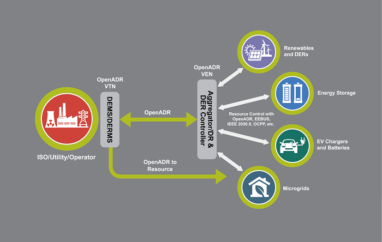-
QUECLINK LAUNCHES COMPACT DMS CAMERA SOLUTION FOR ADVANCED DRIVER MONITORING - 3 hours ago
-
CTRACK AND ARTURA JOIN FORCES TO LAUNCH TELEMATICS-ENABLED ACCIDENT AND REPAIR SOLUTION - April 28, 2025
-
GOPLASTICPALLETS.COM CELEBRATES MONUMENTAL 2,000 TONNE RECYCLING MILESTONE - April 24, 2025
-
LSA INTERNATIONAL CHOOSES PROLOG FULFILMENT TO MANAGE ITS DISTRIBUTION & LOGISTICS - April 23, 2025
-
Uniserve Partners with Logistics Reply to Deliver Transformation to Customers Supply Chains - April 23, 2025
-
Nutrivend selects Forterro’s Orderwise to support online expansion and streamline operations - April 11, 2025
-
ARROWXL LAUNCHES AMBITIOUS ZERO WASTE ROADMAP - April 8, 2025
-
THE BCMPA’S NEW CAMPAIGN DRIVES OUTSOURCING SUCCESS IN Q1 - April 7, 2025
-
BLACKOUT TECHNOLOGIES TARGETS TELEMATICS-INTEGRATED MOBILE DEVICE BLOCKING TO COMBAT SMARTPHONE DISTRACTION - April 1, 2025
-
OpenADR Alliance announces first OpenADR 3.0 certified products with EVoke Systems, E.ON Energy and Universal Devices - March 25, 2025
OpenADR Alliance launches new communications standard to help utilities manage growth in renewable energy sources and EV charging
ENLIT Europe, Paris, France –The OpenADR Alliance, the global industry body created to foster the development, adoption, and compliance of OpenADR, has launched a new version of its OpenADR communications standard. OpenADR 3.0 is designed to support utilities, operators, aggregators, and customers as they try to manage the growing range of distributed energy resources (DER) including renewables, energy storage, electric vehicle (EV) batteries and charging infrastructure, as well as demand response resources like commercial buildings or homes.
As an open standard, OpenADR provides highly secure, fast, and reliable two-way information exchange for utility applications with simple communications needs like dynamic price and event signals, allowing customers to modify their usage to save money and reduce their carbon footprint.
With the launch of OpenADR 3.0, device and equipment manufacturers will be able to add new functionality more easily into customer products, including smart thermostats, EV charging stations, energy storage, and control systems.
Managing & Technical Director for the OpenADR Alliance, Rolf Bienert, comments: “Renewable energy, along with battery storage, is providing a growing share of overall power capacity as we move towards a more sustainable energy future. This means that energy companies are having to manage more decentralised and distributed energy resources, scaling operations while ensuring compatibility and interoperability.
“OpenADR is critical in providing seamless communications between different devices and systems, and between utilities and customers. OpenADR 3.0 provides simplicity at a time when technology is becoming more complex, making energy management easier and future-proofing energy systems. It offers a new alternative using modern web service designs that are easier to use than older message style exchange formats, while also providing added functionality.”
With OpenADR 2.0 used by many utilities and vendors, there are no plans to replace it; OpenADR 3.0 is designed to complement older versions of the standard. Aside from the functionality of 2.0, OpenADR 3.0 simplifies messaging, including pricing, offering more dynamic pricing structures, as well as better enabling greenhouse gas signalling, grid code adjustments, and capacity management communication (e.g., dynamic operating envelopes).
Bruce Nordman, a scientist at Lawrence Berkeley National Laboratory, and member of the team that created OpenADR 3.0, says: “OpenADR 3.0 opens up new possibilities for customers and customer devices. It is so easy to implement that it can readily be put into any customer device (even a Wi-Fi light bulb) for receipt of grid signals, and also used for communication between customer devices. OpenADR 3.0 also supports two mechanisms for capacity management between the grid and the customer.”
Pacific Gas & Electric’s (PG&E) Albert Chiu adds: “As renewable generation and electrification increases with more distributed energy resources, energy flexibility and load management become even more important. With the new and improved OpenADR 3.0, we expect to see more growth in the quantity and diversity of OpenADR certified products and solutions, which will make it easier for customers when participating in load management programs and dynamic rates. All of these activities are critical for PG&E and CA to reach its carbon reduction goal in the future.”
OpenADR 3.0 testing and certification
OpenADR certification encourages the development of a global ecosystem of standards-based products, eliminating single-vendor lock-in and ensuring interoperability. Members can apply soon for OpenADR 3.0 testing and certification, but only products or systems that have been through the OpenADR Alliance Certification Program can claim OpenADR certified status. Testing will be conducted at one of 10 approved test facilities using test assets created by the OpenADR Alliance in collaboration with other vendors.
The OpenADR Alliance has several companies now piloting the new OpenADR 3.0 standard.
The OpenADR Alliance is attending Enlit Europe 2023 (28-30 Nov) in Paris, France on stand no. 7.2.J55, together with several members and partners: AMPECO, Driivz, Fuji Electric, Honeywell, Kaluza, Panasonic, Siemens, Trilliant and SmartEn.























